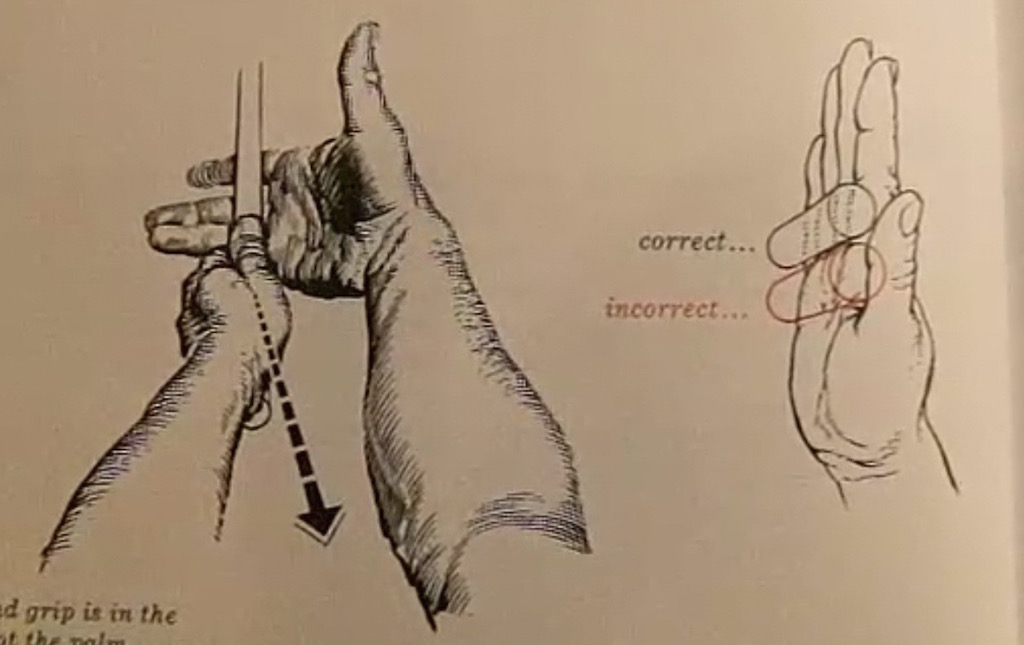Instruction
Kelley: How the concept of a punching motion can change your golf swing

Ever wonder how a simple looking golf swing can produce so much speed and power? The answer may lie in the biomechanics of throwing a punch.
Below is an image of a boxer throwing a right handed hook. Note the direction the body moves to produce maximum force towards the target.

As the boxer pulls back his arm, there is not an excess wind-up or big turn to create power. His body is now geared to go forward and around into the opponent. His body would stay mostly level throughout the motion.
Now lets apply this simple concept to the golf swing. At address, the player would have his upper body and mass positioned behind the ball. In the picture below, note the green line indicting his mass back behind the blue baseline over the ball.

From here, the player can coil around his center, much like a boxer positioned ready to punch.

Now the body can go forward and around towards the target, pulled by the arms. Note the body finishing ahead of the blue baseline.

A body that has a lot of left side bend or “tilt” in the backswing, will naturally counterbalance in the downswing. This will often result with the upper body falling back in the downswing. (Pictured below)

The pattern above would equivalent to attempting to punch forward with your arm while your body is moving backwards. Next time you are looking to make a swing change, first check the movement of your body, and see if it is as simple as boxer throwing a powerful punch.
Twitter: KKelley_golf
- LIKE42
- LEGIT12
- WOW1
- LOL2
- IDHT3
- FLOP1
- OB1
- SHANK10
Instruction
Clement: Weak grips are injuries in the making for many golfers

Like Jordan Spieth, trying to go to a bowed wrist at the top or in the downswing to square the club is placing you in a dangerous position for your lead wrist; you are one tree root or deep rough situation away from a nasty injury that could easily require surgery. Don’t let this be you.
- LIKE0
- LEGIT0
- WOW0
- LOL0
- IDHT0
- FLOP2
- OB0
- SHANK3
Instruction
Clement: Laid-off or perfect fade? Across-the-line or perfect draw?

Some call the image on the left laid off, but if you are hitting a fade, this could be a perfect backswing for it! Same for across the line for a draw! Stop racking your brain with perceived mistakes and simply match backswing to shot shape!
- LIKE1
- LEGIT0
- WOW0
- LOL0
- IDHT0
- FLOP0
- OB0
- SHANK1
Instruction
The Wedge Guy: The easiest-to-learn golf basic

My golf learning began with this simple fact – if you don’t have a fundamentally sound hold on the golf club, it is practically impossible for your body to execute a fundamentally sound golf swing. I’m still a big believer that the golf swing is much easier to execute if you begin with the proper hold on the club.
As you might imagine, I come into contact with hundreds of golfers of all skill levels. And it is very rare to see a good player with a bad hold on the golf club. There are some exceptions, for sure, but they are very few and very far between, and they typically have beat so many balls with their poor grip that they’ve found a way to work around it.
The reality of biophysics is that the body moves only in certain ways – and the particulars of the way you hold the golf club can totally prevent a sound swing motion that allows the club to release properly through the impact zone. The wonderful thing is that anyone can learn how to put a fundamentally sound hold on the golf club, and you can practice it anywhere your hands are not otherwise engaged, like watching TV or just sitting and relaxing.
Whether you prefer an overlap, interlock or full-finger (not baseball!) grip on the club, the same fundamentals apply. Here are the major grip faults I see most often, in the order of the frequency:
Mis-aligned hands
By this I mean that the palms of the two hands are not parallel to each other. Too many golfers have a weak left hand and strong right, or vice versa. The easiest way to learn how to hold the club with your palms aligned properly is to grip a plain wooden ruler or yardstick. It forces the hands to align properly and shows you how that feels. If you grip and re-grip a yardstick several times, then grip a club, you’ll see that the learning curve is almost immediate.
The position of the grip in the upper/left hand
I also observe many golfers who have the butt of the grip too far into the heel pad of the upper hand (the left hand for right-handed players). It’s amazing how much easier it is to release the club through the ball if even 1/4-1/2″ of the butt is beyond the left heel pad. Try this yourself to see what I mean. Swing the club freely with just your left hand and notice the difference in its release from when you hold it at the end of the grip, versus gripping down even a half inch.
To help you really understand how this works, go to the range and hit shots with your five-iron gripped down a full inch to make the club the same length as your seven-iron. You will probably see an amazing shot shape difference, and likely not see as much distance loss as you would expect.
Too much lower (right) hand on the club
It seems like almost all golfers of 8-10 handicap or higher have the club too far into the palm of the lower hand, because that feels “good” if you are trying to control the path of the clubhead to the ball. But the golf swing is not an effort to hit at the ball – it is a swing of the club. The proper hold on the club has the grip underneath the pad at the base of the fingers. This will likely feel “weak” to you — like you cannot control the club like that. EXACTLY. You should not be trying to control the club with your lower/master hand.
Gripping too tightly
Nearly all golfers hold the club too tightly, which tenses up the forearms and prevents a proper release of the club through impact. In order for the club to move back and through properly, you must feel that the club is controlled by the last three fingers of the upper hand, and the middle two fingers of the lower hand. If you engage your thumbs and forefingers in “holding” the club, the result will almost always be a grip that is too tight. Try this for yourself. Hold the club in your upper hand only, and squeeze firmly with just the last three fingers, with the forefinger and thumb off the club entirely. You have good control, but your forearms are not tense. Then begin to squeeze down with your thumb and forefinger and observe the tensing of the entire forearm. This is the way we are made, so the key to preventing tenseness in the arms is to hold the club very lightly with the “pinchers” — the thumbs and forefingers.
So, those are what I believe are the four fundamentals of a good grip. Anyone can learn them in their home or office very quickly. There is no easier way to improve your ball striking consistency and add distance than giving more attention to the way you hold the golf club.
More from the Wedge Guy
- The Wedge Guy: Golf mastery begins with your wedge game
- The Wedge Guy: Why golf is 20 times harder than brain surgery
- The Wedge Guy: Musings on the golf ball rollback
- LIKE91
- LEGIT16
- WOW6
- LOL1
- IDHT0
- FLOP4
- OB1
- SHANK9
-

 News3 weeks ago
News3 weeks agoExperts on understanding ground force and how shoes can impact your golf game
-

 Product Reviews4 days ago
Product Reviews4 days agoThree Swing Challenge: Testing the Edel Array F-2 putter
-

 19th Hole2 weeks ago
19th Hole2 weeks ago‘You’re right, we’re always wrong!’ – Sergio Garcia receives warning during Open qualifier
-

 Equipment5 days ago
Equipment5 days agoWhat clubs do equipment free agents choose to use on tour? We found out
-

 News1 week ago
News1 week agoHighlights from the Wilson Golf Product Testing and Fitting Experience at Pinehurst
-

 News1 week ago
News1 week agoDavis Thompson’s winning WITB: 2024 John Deere Classic
-

 19th Hole7 days ago
19th Hole7 days agoMajor champ ‘disappointed’ not to be chosen as U.S. Ryder Cup captain
-

 Equipment2 weeks ago
Equipment2 weeks agoQ&A: The truth behind Bryson DeChambeau’s new Avoda irons from company founder Thomas Bailey




















Rob Eberle
Aug 18, 2023 at 4:59 pm
Uhhh. Sorry but that is not a “right hook”. It is a straight right. The mechanics are very different. To confuse the two is like confusing a putter and a hybrid.
Try to stick to things you know. Not clear if that is the golf swing, but it certainly is not boxing.
Greg Urban
Jul 8, 2023 at 2:02 pm
I’m confused with this instruction. A side note: I have noticed the past few years more tour pros position their hands lower, closer to the thighs at set up and thus have their shoulder tilted more to the ground. Anyone else notice this?
Jimmy
Jul 5, 2023 at 1:55 pm
I get the punching analogy but if this guy is saying to pull the arms down he’s clueless.
Fred Lyndon
Jul 5, 2023 at 10:27 am
Recipe for a flat shoulder plane and arm swing.
I have often wondered if some teachers have given up on teaching a proper swing, or just don’t know what one is.
The ball is on the ground, you have to tilt your shoulders to hit it well.
Try picking something on the ground without tilting your shoulders.
Mr T
Jul 5, 2023 at 2:00 pm
He has the golf swing confused with a baseball swing.